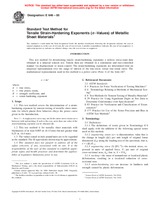Potrebujeme váš súhlas na využitie jednotlivých dát, aby sa vám okrem iného mohli ukazovať informácie týkajúce sa vašich záujmov. Súhlas udelíte kliknutím na tlačidlo „OK“.
ASTM E646-00
Standard Test Method for Tensile Strain-Hardening Exponents (n-Values) of Metallic Sheet Materials
Automaticky preložený názov:
Štandardná skúšobná metóda pre ťahovom tvrdnúce exponentmi ( N - hodnôt ) kovová materiálov
NORMA vydaná dňa 10.5.2000
Informácie o norme:
Označenie normy: ASTM E646-00
Poznámka: NEPLATNÁ
Dátum vydania normy: 10.5.2000
Kód tovaru: NS-47495
Počet strán: 8
Približná hmotnosť: 24 g (0.05 libier)
Krajina: Americká technická norma
Kategória: Technické normy ASTM
Anotácia textu normy ASTM E646-00 :
Keywords:
Metals and metallic materials, Steel sheet, Steel sheet/strip/plate-general, Strain-hardening exponents (n-values), Strain testing-metallic materials, Tension (tensile) properties/tests-metallic materials, tensile strain-hardening exponents (n-values) of metallic sheet, materials, test, ICS Number Code 77.140.50 (Flat steel products and semi-products)
Doplňujúce informácie
| Significance and Use | ||||||||||||||||
|
This test method is useful for estimating the strain at the onset of necking in a uniaxial tension test (1). Practically, it provides an empirical parameter for appraising the relative stretch formability of similar metallic systems. The strain-hardening exponent is also a measure of the increase in strength of a material due to plastic deformation. The strain-hardening exponent may be determined over the entire plastic stress-strain curve or any portion(s) of the stress-strain curve specified in a product specification. Note 3—The strain interval 10–20% is commonly utilized for determining the n-value of formable low carbon steel products. This test method is not intended to apply to any portion of the true-stress versus true-strain curve that exhibits discontinuous behavior; however, the method may be applied by curve-smoothing techniques as agreed upon. Note 4—For example, those portions of the stress-strain curves for mild steel or aluminum alloys which exhibit yield-point elongation or Lüders bands may be characterized as behaving discontinuously. Note 5—Caution should be observed in the use of curve-smoothing techniques as they may affect the n-value. This test method is suitable for determining the tensile stress-strain response of metallic sheet materials in the plastic region prior to the onset of necking. The n-value may vary with the displacement rate or strain rate used, depending on the metal and test temperature. |
||||||||||||||||
| 1. Scope | ||||||||||||||||
|
1.1 This test method covers the determination of a strain-hardening exponent by tension testing of metallic sheet materials for which plastic-flow behavior obeys the power curve given in the Introduction. 1.2 This test method is for metallic sheet materials with thicknesses of at least 0.005 in. (0.13 mm) but not greater than 0.25 in. (6.4 mm). 1.3 The values stated in inch-pound units are to be regarded as the standard. The SI equivalents shown may be approximate. 1.4 This standard does not purport to address all of the safety problems, if any, associated with its use. It is the responsibility of the user of this standard to establish appropriate safety and health practices and determine the applicability of regulatory limitations prior to use. |
||||||||||||||||
| 2. Referenced Documents | ||||||||||||||||
|
Odporúčame:
Aktualizácia technických noriem
Chcete mať istotu, že používate len platné technické normy?
Ponúkame Vám riešenie, ktoré Vám zaistí mesačný prehľad o aktuálnosti noriem, ktoré používate.
Chcete vedieť viac informácií ? Pozrite sa na túto stránku.




 Cookies
Cookies
